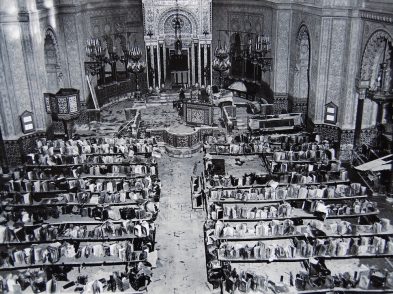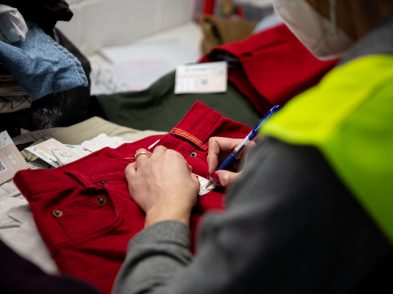Arturo Galansino, Director General of the Palazzo Strozzi Foundation, talks to The Florentine about Palazzo Strozzi’s forthcoming installations and exhibitions, plus the public-private institution’s further embracing of the digital in 2021.
Alexandra Korey: Palazzo Strozzi is Florence’s foremost face for modern and contemporary art, and that’s something you’ve very much brought to the table in recent years since you joined us in 2015.
Arturo Galansino: What we wanted to do was to find a new strategy for Palazzo Strozzi, a new wave. We bet on contemporary art, and we became the most attended, most successful contemporary art base in Italy very quickly. We broke all the records, so we’re proud of what we did, especially because we did it in Florence, a city that wasn’t exactly the obvious choice for a new mecca for contemporary art.
AK: We’re really looking forward to the special solution you’ve come up with for this difficult moment in time where, in the short term at least, we cannot enter exhibition spaces. Could you tell us what we’re going to be looking forward to starting December 3?
AG: Our next project—it’s more a project than an exhibition—is by Marinella Senatore: We Rise By Lifting Others. It’s a multidisciplinary project consisting of an installation in the courtyard; it’s a light installation, so it’s perfect for Christmas time, but it’s inspired by the folkloristic South Italian light installations, which can be found in Puglia, in Sicily, especially in the summer. This kind of work became famous with Marinella Senatore last summer because she organized a catwalk for Christian Dior using this type of setting. Of course, this installation is just the starting point of a series of digital programs because exhibitions aren’t allowed right now. Let’s call it a possible project in a moment where museums and exhibitions are impossible. In having this installation in the courtyard, it’ll be free for everybody. Our courtyard is like a piazza, so it’ll be accessible to everyone walking through the centre of Florence. This installation is also a starting point because these lights are full of sentences, mottos and phrases of empowerment. Working on these sentences, Marinella will develop a series of live workshops that will be a crucial moment for our activity because we will be able to reconnect with our public again. The workshops are already fully booked, but there’ll be some content that we will broadcast through our social media very soon, so everyone can see what’s happening. We’ll recreate a social connection with our public.

A rendering of Marinella Senatore’s installation at Palazzo Strozzi, “We Rise By Lifting Others”
AK: Some of them are for the general public, but then some are for the fragile public too, which is something I know Palazzo Strozzi has been involved in.
AG: Our participants will be people belonging to a fragile environment, such as people from day care centres, nursing homes, inmates from the Sollicciano prison, but also teachers, educators, artists, volunteers and, of course, students.
AK: It was very interesting to observe how, during the first lockdown when the exhibition by Tomás Saraceno had just opened, you didn’t limit your online conversation just to that. You developed this whole plan that allowed us to remain in contact during that period. Could you tell us more about that initiative?
AG: During the first lockdown we started this digital project called In Contatto – In Touch; we wanted to be in touch with our public. For us, it was very unusual to close our exhibition space—it was the first time ever we lost that connection with our public. So, we quickly developed a completely spontaneous response to this new situation: a program focusing on some content that, at the time and still today, became very important. We dug through our past programs and exhibitions, and we found some interesting topics, developing content from these topics, which were also particularly relevant. For example, we were talking about home, about alienation, isolation, cooking, family… All these new words and topics that became so central to the time. We found a good starting point in one of our past program exhibitions. It was great to have the opportunity to restart the exhibition with a fresh look and we were very successful in terms of numbers.

Tomás Saraceno, “Stillness in Motion – Cloud Cities”, 2016
© Photography by Studio Tomás Saraceno, 2016
AK: In any moment, we can look at art and art history, whether older, modern or contemporary or modern, and find ways that it connects to whatever is happening right now. Isn’t that one of the magical things about art?
AG: Yes, I think we can definitely say that. We were talking about this incredibly relevant theme that may be connected with a Renaissance exhibition, or with other contemporary art, so there’s always many interesting topics in our varied program that we’ve had over the last ten years. A crucial part of this new digital strategy was the video messages from our artists. We had some great messages from Marina Abramović, Ai Weiwei, Jeff Koons and, of course, Tomás Saraceno: Tomás’ exhibition was the starting point of this strategy. We’d just opened the show a few days before the first lockdown and then we had to close until June. The exhibition finished at the beginning of November following great success with the public and critics alike. But his exhibition was the starting point because it was the perfect show at the time because Aria made us aware of how all our actions have an effect on the environment, on our world that we live in. This was one of the reasons why the exhibition was called “prophetic” many times by the press.
AK: Did the exhibition evolve in some way? Were the spiders still making their webs? Did you go in and see how it was changing on its own?
AG: Of course, there was some kind of maintenance we needed to do every day, so we’d go into the exhibition a lot. As you know, some of these installations were living installations, especially with the one where spiders were involved, so things definitely changed. We sometimes had some problems with our plants, meaning we’d have to change them, but the spiders were in perfect shape!
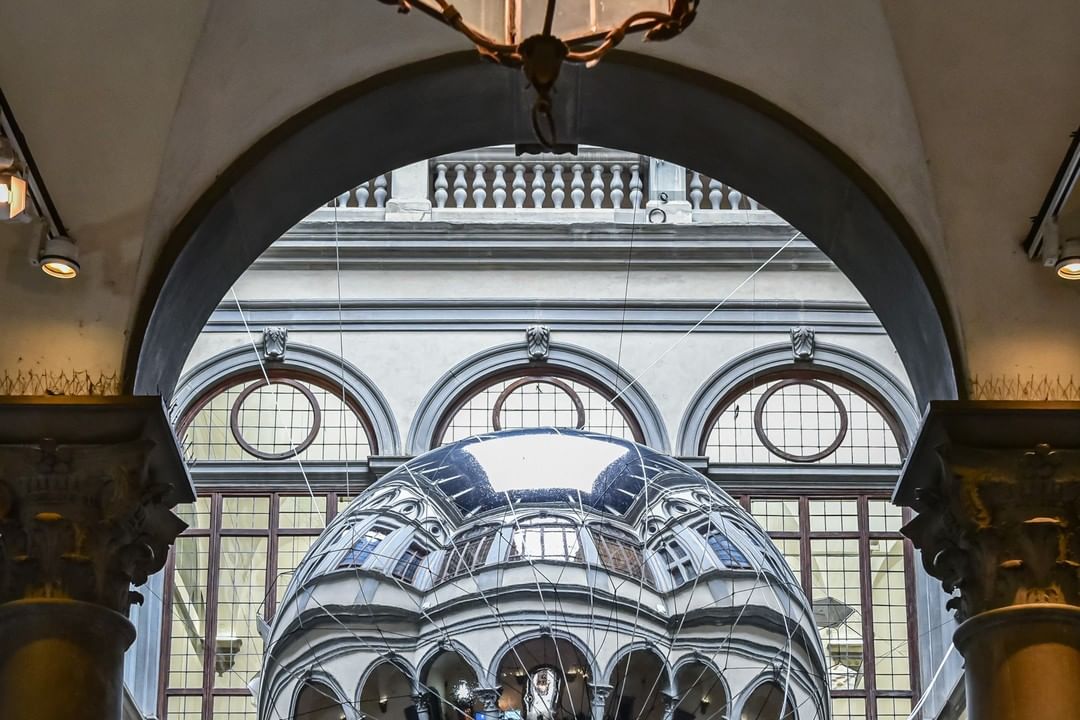
Tomás Saraceno, “Thermodynamic Constellation | Costellazione termodinamica” (pre-setup detail), 2020.
Photography © Ela Bialkowska, OKNOstudio.
AK: The digital world is evolving, and it’s always evolving very quickly. You released a press release saying the readership numbers for In Contatto were superb: you had 60,000 users in less than 90 days. Your editorial team was publishing twice weekly, so you evolved to a bi-weekly column since last June. As we spend our days in Zoom chats as well as all our meetings and calls, there is a bit of a digital fatigue setting in. Is that why you’re cutting down? How do you think that the digital technology is evolving at this time and how do you see it related to what you’re doing in the museum?
AG: For sure, there’s a kind of digital fatigue. During the first few weeks of the first lockdown, everyone was rushing to create a digital strategy and sometimes the results were good, sometimes not so much. We had a lot of different reactions about that. Art people felt a little lost because they were missing out a lot when they first locked down. These people are normally running around the world for art fairs or exhibitions; this was our life before the pandemic. The shock was huge, so the digital content probably helped in a way. Now I think everything’s changed. The digital situation is calmer and more controlled. It’s quite clear that the digital experience is something different; it’s not comparable to the physical one. Everyone seems to be aware of this. There’s nothing comparable to the physical experience of being in the presence of art and our work. The museum work is to create this connection between the art and the public. For us, the digital activity is just parallel to the physical one. We’re able to create something physical anyway, like with Marinella, but at the same time, we’re also aware that digital content is becoming more and more important. Now, with all the exhibitions—not only the Marinella Senatore project—distribution will be developed and doubled up, being exhibited both physically and with strong digital content on the side. In this way, I hope our digital content will be able to enhance the knowledge of our public to function as a parallel experience.
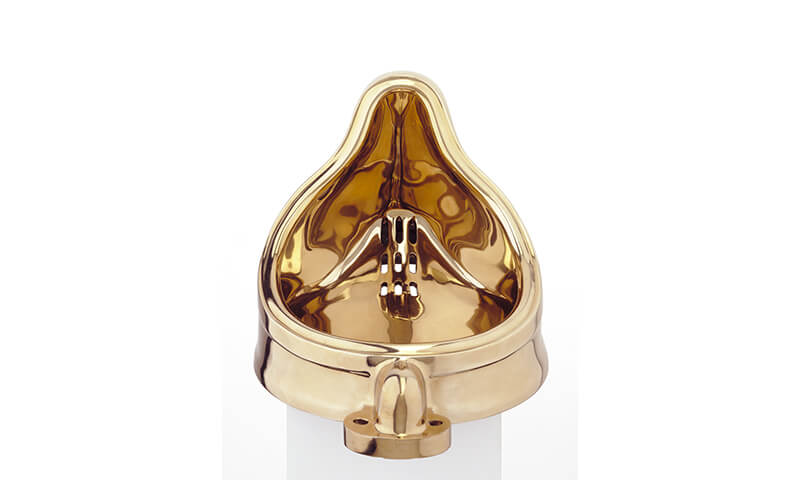
Sherrie Levine, Fountain (after Marcel Duchamp: AR), 1991 Minneapolis, Collection Walker Art Center
AK: This is great news for those who can’t make it to Florence anyway, whether it’s because of the pandemic or because not everyone can come every year. We do have a lot of people who love Palazzo Strozzi, who love Florence, and they can’t make it to every show. So, if we get a little digital something on the side, it’s a nice way to open everything up to the world. This organically leads us into chatting about the 2021 exhibition calendar. You recently announced it in the hope that from March until the end of the year it’ll be possible to visit in person. Two shows: one modern, one contemporary, and we have an American theme. Tell us a little bit more about American art and also the work displayed on the poster.
AG: 2021 will be a fully American art year. We’re very excited about our future programme, starting in springtime with our American Art 1961-2001 exhibition. It’s a major show spanning forty years of American art history. The image on the poster is a sculpture by Sherrie Levine, a homage to Marcel Duchamp. I chose this as the leading image for the show because it embodies the “Duchampion” element of World War II. You’ll see a lot of homages to Marcel Duchamp, and then also because the author is a female artist, there are a lot of female artists in this show. In a way, we wanted to give the right space to the female artists because American art is not only a white male output, but it’s also done by great female artists as well as artists belonging to other communities. There’ll be a lot of variety of American art. Cindy Sherman is another female who’s part of this discourse. But we also have the super classic names of American art such as Jasper Johns, Donald Judd, Robert Mapplethorpe, Bruce Nauman, Robert Rauschenberg, Andy Warhol… We’ll have a big room devoted to pop art. Twenty years after 2001, we see our lives changing again, so the chronology is completely new. I think this is the first exhibitions to span 1961 and 2001; from JFK to George Bush Jr., from Vietnam to the Twin Towers. It’ll be a good recap about American history, not only about American art. Furthermore, this is a great homage to the collection of the Walker Art Center in Minneapolis because more than 90 of these masterpieces coming from that collection, which is one of the leading institutions of contemporary art in the world. Of course, it’s less famous than MoMA, for instance, because not everybody goes on holiday there. So, it’ll be a great way to find out more about this institution and about their collecting strategies because this history of American art is not complete—there’s just a choice made by The Walker in the last 50 years of collecting.
AK: Will it be organized by theme or chronology? What can you tell us about the logic behind the show?
AG: Because it’s a historical show we’re following a chronological path, but it’ll also be thematic at the same time. We’re going to see the different movements throughout the different decades. We start with the post abstract expressionism, going into pop art, minimal art, Neo-Dada—Rauschenberg and Johns in particular—and then the picture generation, body art and performance, and then the art of the ‘90s art and all these racial issues, gender identity and struggles for civil rights that we can see in art between the ‘90s and the beginning of the 2000s. It’s a very rich show and I’m sure you’ll be amazed. There are also a lot of surprises, but I can’t tell you everything now!

Jeff Koons, Rabbit, 1986
Collection Museum of Contemporary Art Chicago
Photo by Nathan Keay, © MCA Chicago, © Jeff Koons
AK: Of course not! This sets us up for the following show, which is called Shine and is a retrospective of Jeff Koons. It sounds to me like the perfect show for the Instagram age as all of us are looking at our own reflections.
AG: I don’t know if it’s the perfect show for Instagram. It probably it, but most of these works were done many years before Instagram. It’s an exhibition spanning the entire career of Jeff Koons, probably the most famous living artist now, as well as the richest, most expensive and most controversial. But at Palazzo Strozzi we try to give the sense of the variety of contemporary artwork, inviting the most important protagonists of contemporary art. So, now it’s Jeff Koons’ turn. We had Ai Weiwei, Marina Abramović and many others. Now we have to celebrate Jeff’s output, also because his career is becoming more historical, having started more than forty years ago at the end of the Seventies and still now one of the leading figures of global art world. Maybe he was the first super global artist, and in a way this exhibition is a kind of a coda of the previous one as Jeff’s presence is missing in the previous exhibition of American art. It’s a monographic show, a historical show on Jeff’s output and there’s a refrain, the appearance of this shining texture of his works. It’s something that Jeff has been working on since the beginning and still does so now. There’s also his philosophical reflection around this concept of “shine” in English, which also means “appearance” in German, so there’s this reflection and appearance in the essence of his works; it’s very conceptual, another pupil of Duchamp in a way. Many of Jeff’s words are a homage to the father of conceptual art. But, as you said, it’ll be a spectacular show because I’m sure this big sculpture will be a fetish for all our public. There’ll be a lot of Instagram for sure.
AK: Jeff Koons is very into experiencing the art. He seems like a nice guy. Did you get to work closely with him on the show?
AG: Yes, we’ve been working with Jeff and his studio for a long time now, at least three years. He’s super professional and a great perfectionist; all the great artists are like that. As you know, this exhibition was supposed to be now, but we had to postpone because of the pandemic, so it’s a very advanced project. Jeff is a modern master and he wants to relate with Florence’s history. Jeff loves Florence. He’s been to Florence and Italy many times. There was a moment in his life when he was really linked to our country and he’s also a collector of old masters. It will be the perfect moment to celebrate Jeff now because I think next year the situation will have improved and everyone will be able to travel again. Florence needs these big events to attract international high-quality tourism, which is our goal.
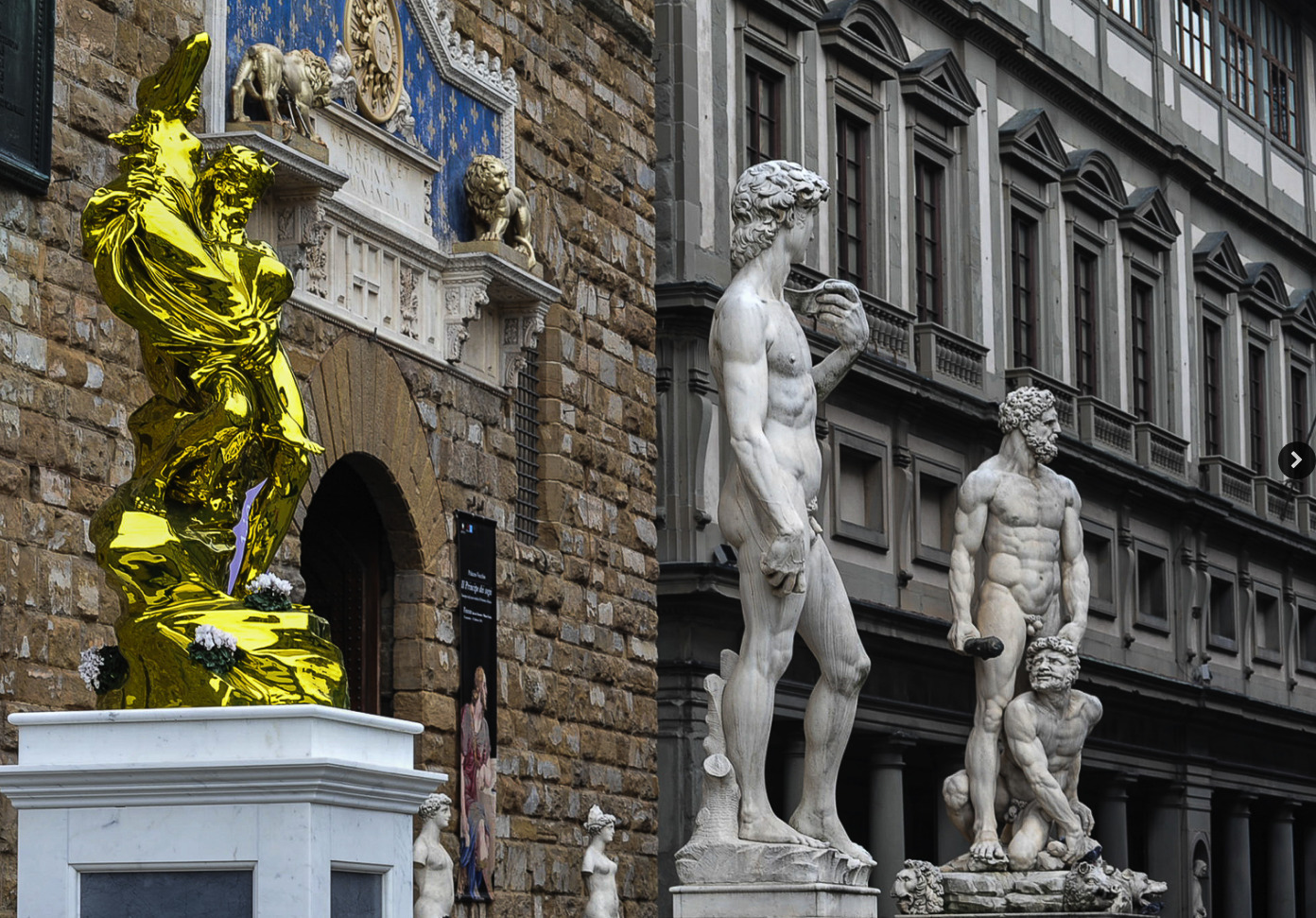
Jeff Koons, Proserpina, Florence
AK: Jeff was in Florence in 2015 when his statue of Proserpina was displayed in front of Palazzo Vecchio, and he received the keys to the city. At the time, my colleague Michelle Davis interviewed him for The Florentine. I was watching the video the other day and Jeff Koons said that artists want dialogue with other artists to make connections. He affirmed how he was feeling so connected to the Florentine artists who were displayed there in piazza della Signoria, so it does indeed seem timely to present this kind of connection, at a time when connection is probably what we most seek as art viewers and the art experience, which brings us full circle to In Contatto and the mission of Palazzo Strozzi.
AG: Our mission is to bring the most important art events in our country to Florence, which we’re still able to do now even in this very difficult moment. We’re always committed to addressing the most relevant topics, the issues of our times, which is one of the reasons of our success. It’s the reason why we are able to make contemporary art accessible to the general public. We’re working for our public to help their education and accessibility in many ways. We’ve gone even more digitally than before this time and this will be our future, and hopefully next year there’ll be a new Renaissance for Florence. Florence will be able to be reborn again, rich and flourishing as it was until last year. We hope to be part of this rebirth.
AK: That sounds like a wonderful augurio! I’m hoping that 2021 can move ahead as planned, so maybe this is an opportunity to become a member of Palazzo Strozzi. You have a membership program for individuals, right?
AG: We have many membership programs. There are many ways to join the Palazzo Strozzi family. The easiest way is to become a friend of Palazzo Strozzi, in which you buy a card that allows you, your partner, family or friends to come as many times as you want. If you like, you can be a patron or sponsor. We’re a private public institution: our budget consists of more than 80 per cent of private money, which is incredible in Italy. It’s very unique that we rely on the philanthropy of our public and people.

